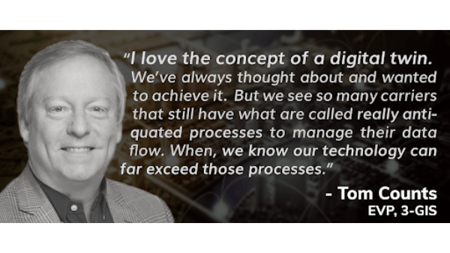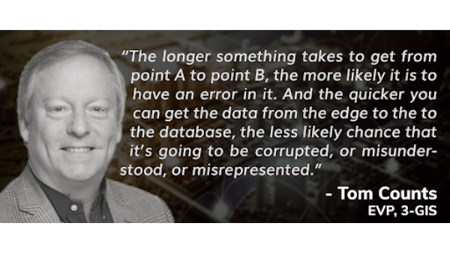So, here is a question for you: why are we often so reluctant to change in business? Is it habit? Or maybe it’s the old adage "if it ain't broke, then don't fix it"? If that is the case, then a larger question may be how do we really know when to distinguish between what technically "ain't broke" versus what is just largely inefficient? This ability to know the difference, like many, is one often borne from extensive experience.
And extensive experience is exactly what we brought to the latest podcast episode of Fiberside chat to discuss the lack of material improvement in geospatial data quality over the last several decades. Combined with more than 70 years of telecom and GIS experience to be more precise, our guests Tom Counts, 3-GIS EVP, and Peter Batty, Chief Research Officer for SSP Innovations, have both worked to continually advance the GIS industry over the last four decades, and most of that time as direct competitors. Now that they are under the same roof, for the first time they are able to synergistically tackle challenges within the telecom industry.
 While the premise of the conversation focuses primarily on the lack of material improvement in geospatial data quality in telecom over the last 30 years, it quickly reveals a glaring root cause: the lack of technology-aligned process adoption. In other words, for a lot of companies, the operational process has not maintained the same pace as the technology designed to make those processes more efficient, and in many cases, automated.
While the premise of the conversation focuses primarily on the lack of material improvement in geospatial data quality in telecom over the last 30 years, it quickly reveals a glaring root cause: the lack of technology-aligned process adoption. In other words, for a lot of companies, the operational process has not maintained the same pace as the technology designed to make those processes more efficient, and in many cases, automated.
"We see so many carriers that still have what are called really antiquated processes to manage their data flow. When we know our technology can far exceed those processes," says Counts in response to why quality geospatial data is still an issue for many companies. One area where technology has  improved drastically is the mobile capabilities of data capture. "We have a community of field technicians today that natively grew up with mobile tools. You’ve got a phone that has incredible GPS accuracy, 20 megapixel camera, massive data capacity and you get 5G connectivity to get that data right back to data stores that immediately can be connected to the OSS and BSS. To not take advantage of that is doing a disservice to your organization and to your shareholders. So, I believe the first thing to do is to trust the edge.”
improved drastically is the mobile capabilities of data capture. "We have a community of field technicians today that natively grew up with mobile tools. You’ve got a phone that has incredible GPS accuracy, 20 megapixel camera, massive data capacity and you get 5G connectivity to get that data right back to data stores that immediately can be connected to the OSS and BSS. To not take advantage of that is doing a disservice to your organization and to your shareholders. So, I believe the first thing to do is to trust the edge.”
"Trust the edge", meaning that one step companies can take to improve their data quality is to train and direct their field techs to maximize usage of available mobile tools to capture and report GIS data directly to the central database, or system of record, in real-time. Batty adds, "having high quality geospatial data is fundamental to be able to quickly diagnose where the problem is and how to fix it versus going into the field and trying to hunt around," later adding, "in order to transform a lot of processes, you really need this good digital model representing your physical network, which is what the GIS data gives you.”
the problem is and how to fix it versus going into the field and trying to hunt around," later adding, "in order to transform a lot of processes, you really need this good digital model representing your physical network, which is what the GIS data gives you.”
“The longer something takes to get from point A to point B, the more likely it is to have an error in it. And the quicker you can get the data from the edge to the to the database, the less likely chance that it’s going to be corrupted, or misunderstood, or misrepresented," says Counts, speaking to how traditional processes have created multi-layered bureaucracies within telecom companies, creating a vicious cycle of endless backlogs and a rarely, if ever, accurate database.
Batty asserts that, if nothing else, current and forthcoming technologies will eventually drive the desire for companies to change from their traditional processes, “if it’s 10 times better or a 10th of the cost, it becomes so absolutely compelling that you can’t ignore it.” He continues  discussing advancements in other industries becoming adopted by the telecom industry. “There are a number of technologies that are available today that really are game changers. If you look at what Tesla is doing, they have cameras that are in their cars that have self-driving technology. Those cameras are recognizing in real time, multiple times a second, stop signs, street lights, traffic lights, people, cars. They are recognizing geospatial features in real time, which is exactly the sort of thing we want to do in our industry.”
discussing advancements in other industries becoming adopted by the telecom industry. “There are a number of technologies that are available today that really are game changers. If you look at what Tesla is doing, they have cameras that are in their cars that have self-driving technology. Those cameras are recognizing in real time, multiple times a second, stop signs, street lights, traffic lights, people, cars. They are recognizing geospatial features in real time, which is exactly the sort of thing we want to do in our industry.”
His current vision extends to working with computer vision and machine learning to further automate and verify data capture in the field. “The system is just watching and feeding data back and that sounds quite sci-fi but in many ways, all of the key elements of being able to do that are there today or we can see them coming in the next couple of years. So that really will be transformational.”
In short, capturing data will continue to advance and transform, with automation playing a key role. However, to avoid losing their competitive advantage today, telcos must prioritize ways to adapt and adopt better processes more aligned with available technology. Unless addressed, poor data capture will continue to delay processes and hinder progression for future fiber buildouts despite the technology.
Listen to the entire podcast with these two industry titans online here or download the episode from iTunes or Spotify.
